Intelligent Infant Cradle with Automated Monitoring & Soothing System
Main Article Content
Abstract
Innovative approaches to baby care are becoming more and more necessary as the number of working parents rises. Because traditional cradles lack real-time monitoring features, it might be challenging for parents to remotely monitor their child's safety and wellbeing. This review of the literature looks at the developments in Internet of Things-based smart cradle systems, emphasizing how they might improve baby safety and give parents peace of mind. The investigation examines a number of experiments that have combined IoT technology with cradles, adding sensors to track variables including baby movement, sound levels, ambient temperature, and humidity. Microcontrollers like Arduino and Node MCU are used in these systems to process sensor data and connect with caregivers through web-based interfaces or mobile applications. Some models have automated functions that, when they hear a baby cry, change the surroundings, play lullabies, or start a swinging motion. This survey evaluates previous research to determine the advantages and disadvantages of the smart cradle systems in use today. The results offer a strong basis for upcoming advancements in baby monitoring technologies, with a focus on increased automation, safety, and responsiveness.
